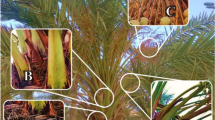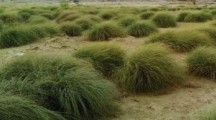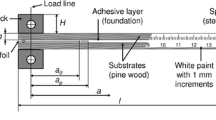Abstract
Flexural behavior of red deer’s (Cervus Elaphus) antler is managed by not only orientation of osteons but also age, number density of fully fledged Cross-Linking Fibers (CLFs) and mineralization. Although crack propagation is affected by all these factors, a possible role of CLFs during the deformation remains rather disguised. The aim of this study was to enlighten the effect of dimensions, micro skeleton and mineral content of CLFs on plastic deformation. Therefore, mechanical properties, microarchitecture and mineralization of fracture sites of deer antlers were investigated using three-point bending tests in 32 specimens followed by high resolution scanning electron microscopy (SEM) and Energy Dispersive X-ray Spectroscopy (EDS). The bending tests show that maximum bending strength is in the range of 150–177 MPa, and elastic modulus approximates to 5–6 GPa. Furthermore, fracture toughness of the test specimens examined for all branching groups of antlers was 8–9 MPa\(\cdot \)m\(^{1/2}\). Age and the number of branching albeit are main reasons for differentiating microarchitecture and varying mechanical properties. SEM analyses show that a hierarchical architecture from bottom to up exists, in which some feathers and nano-sized fibrils are attached to larger fibrils that brings CLFs altogether. Antlers of adolescent deers are supposed to have shorter and thinner cross-linking fibers than elder ones. Some feathered micro-fibrils were identified across the CLFs connecting osteons. The thickness (270.0–320.0 nm) and length (700 nm) of feathers were strictly proportional to the microfibrils’ size (10.0 µm in length and 1.0 µm in thickness). Furthermore, weight percentages of minerals varies along the CLFs that taking root on osteons by a bundle of many smaller fibrils whereas Pb, Cd and Hg have the highest values at the tip of broken CLFs. Such high values of these brittle elements lead to cracked ligament bridging as well.

















Similar content being viewed by others
Abbreviations
- SEM:
-
Scanning Electron Microscopy
- EDS:
-
Energy Dispersive Spectroscopy
- CLF:
-
Cross-Linking Fiber
- SB-A:
-
Six Branch Antler
- FB-A:
-
Five Branch Antler
- TB-A:
-
Two Branch Antler
- \(\sigma _f\) :
-
Bending Strength
- \(\epsilon _f\) :
-
Flexural Strain
- \(E_f\) :
-
Flexural Modulus
- \(K_{IC}\) :
-
Fracture Toughness
- \(\rho \) :
-
Density
References
Chapman D I 1975 Antlers–bones of contention. Mamm. Rev. 5: 121–172
Fennessy P F 1984 Deer antlers: Regeneration, function and evolution. J. R. Soc. N. Z. 14: 290–291
Modell W 1969 Horns and antlers. Scientific American 220: 114–123
Geist V 1966 The evolution of horn-like organs. Behaviour 27: 175 – 214
Landete-Castillejos T, García A, Serrano M P, Ceacero F, Cappelli J, Gambin P and Gallego L 2016 Analysis of antler composition and mechanical properties reveal key micro-minerals for deer. In: Deer Nutrition and Feeding Czech Republic (pp. 22–29)
Bartos L, Perner V and Losos S 1988 Red deer stags rank position, body weight and antler growth. Acta Theriol. 33: 209–217
Rolf H J and Enderle A 1999 Hard fallow deer antler: A living bone till antler casting?. Anat. Rec. 255: 69–77
Mkukuma L D, Skakle J M S, Gibson I R, Imrie C T, Aspden R M and Hukins D W L 2004 Effect of the proportion of organic material in bone on thermal decomposition of bone mineral: an investigation of a variety of bones from different species using thermogravimetric analysis coupled to mass spectrometry, high-temperature x-ray diffraction, and fourier transform infrared spectroscopy. Calcif. Tissue Int. 75: 321–328
Currey J D 1979 Mechanical properties of bone tissues with greatly differing functions. J. Biomech. 12: 313–319
Gibson L J and Ashby M F 1999, Cellular Solids: Structure and Properties, Cambridge Solid State Science Series, Second Edition, Cambridge University Press (pp. 3–7)
Currey J D 1984 Comparative mechanical properties and histology of bone. Am. Zool. 24: 5–12
Currey J D 1975 The effects of strain rate, reconstruction and mineral content on some mechanical properties of bovine bone. J. Biomech. 8: 81–86
Currey J D 1988 Strain rate and mineral content in fracture models of bone. J. Orthop. Res. 6: 32–38
Bonfield W and Clark E A 1973 Elastic deformation of compact bone. J. Mater. Sci. 8: 1590–1594
Reilly D T and Burstein A H 1975 The elastic and ultimate properties of compact bone tissue. J. Biomech. 8: 393–405
Ascenzi A and Bonucci E 1964 The ultimate tensile strength of single osteons. Cells Tissues Organs 58: 160–183
Rajaram A and Ramanathan N 1982 Tensile properties of antler bone. Calcif. Tissue Int. 34: 301–305
Cappelli J, Atzori A S, Ceacero F, Landete-Castillejos T, Cannas A, Gallego L and García A J 2017 Morphology, chemical composition, mechanical properties and structure in antler of sardinian red deer (cervus elaphus corsicanus). Hystrix Ital. J. Mammal. 28: 110–112
Landete-Castillejos T, Currey J D, Estevez J A, Fierro Y, Calatayud A, Ceacero F and Gallego L 2010 Do drastic weather effects on diet influence changes in chemical composition, mechanical properties and structure in deer antlers?. Bone 47: 815–825
Landete-Castillejos T, Currey J D, Estevez J A, Gaspar-López E, Garcia A and Gallego L 2007 Influence of physiological effort of growth and chemical composition on antler bone mechanical properties. Bone 41: 794–803
Currey J D, Landete-Castillejos T, Estevez J, Ceacero F, Olguin A, Garcia A and Gallego L 2009 The mechanical properties of red deer antler bone when used in fighting. J. Exp. Biol. 212: 3985–3993
Meister W W 1956 Changes in histological structure of the long bones of white-tailed deer (Odocoileus virginianus) during the growth of the antlers. Anat. Rec. 124: 709–721
McCalden R W , McGeough J A, Barker M B, Court-Brown C M 1993 Age-related changes in the tensile properties of cortical bone. the relative importance of changes in porosity, mineralization, and microstructure. J. Bone Joint Surg. American volume. American volume. 75: 1193–1205
Chen P Y, Stokes A G and McKittrick J 2009 Comparison of the structure and mechanical properties of bovine femur bone and antler of the north american elk (cervus elaphus canadensis). Acta Biomater. 5: 693–706
Buddhachat K, Klinhom S, Siengdee P, Brown J L, Nomsiri R, Kaewmong P, Thitaram C, Mahakkanukrauh P and Nganvongpanit K 2016 Elemental analysis of bone, teeth, horn and antler in different animal species using non-invasive handheld x-ray fluorescence. PLOS ONE 11: 1–21
Balter V 2004 Allometric constraints on sr/ca and ba/ca partitioning in terrestrial mammalian trophic chains. Oecologia 139: 83–88
Alfvén T, Elinder C G, Hellström L, Lagarde F and Järup L 2004 Cadmium exposure and distal forearm fractures. J. Bone Miner. Res. 19: 900–905
Staessen J, RoelsH A, Emelianov D, Kuznetsova T, Thijs L, Vangronsveld J and Fagard R 1999 Environmental exposure to cadmium, forearm bone density, and risk of fractures: prospective population study. Lancet 353: 1140–1144
Engström A, Michaëlsson K, Vahter M, Julin B, Wolk A and Åkesson A 2012 Associations between dietary cadmium exposure and bone mineral density and risk of osteoporosis and fractures among women. Bone 50: 1372–1378
Wallin M, Barregard L, Sallsten G, Lundh T, Karlsson M K, Lorentzon M, Ohlsson C and Mellström D 2016 Low-level cadmium exposure is associated with decreased bone mineral density and increased risk of incident fractures in elderly men: the mros sweden study. J. Bone Miner. Res. 31: 732–741
Bernard A 2008 Cadmium & its adverse effects on human health. Indian J. Med. Res. 128: 557–564
Chen X, Zhu G, Jin T, Lei L and Liang Y 2011 Bone mineral density is related with previous renal dysfunction caused by cadmium exposure. Environ. Toxicol. Pharmacol. 32: 46–53
Johri N, Jacquillet G and Unwin R 2010 Heavy metal poisoning: the effects of cadmium on the kidney. Biometals 23: 783–792
Rodríguez J and Mandalunis P M 2018 A review of metal exposure and its effects on bone health. J. Toxicol. 2018: 1–11
Monir A U, Gundberg C M, Yagerman S E, MeulenM C H, Budell W C, Boskey A L and Dowd T L 2010 The effect of lead on bone mineral properties from female adult c57/bl6 mice. Bone 47: 888–894
Jamieson J A, Taylor C G and Weiler H A 2006 Marginal zinc deficiency exacerbates bone lead accumulation and high dietary zinc attenuates lead accumulation at the expense of bone density in growing rats. Toxicol. Sci. 92: 286–294
Palaniappan P L, Krishnakumar N, Vadivelu M and Vijayasundaram V 2010 The study of the changes in the biochemical and mineral contents of bones of catla catla due to lead intoxication. Environ. Toxicol. Int. J. 25: 61–67
Gangoso L, Alvarez-Lloret P, Rodríguez-Navarro A, Mateo R, Hiraldo F and Donazar J A 2009 Long-term effects of lead poisoning on bone mineralization in vultures exposed to ammunition sources. Environ. Pollut. 157: 569–574
ASTM Standard 2002 E399-90, standard test method for plane strain fracture toughness of metallic materials. Annual Book of ASTM Standards, ASTM International (pp. 443–473)
Zweben C, Smith W S and Wardle M W 1979 Test methods for fiber tensile strength, composite flexural modulus, and properties of fabric-reinforced laminates. In: Composite Materials: Testing and Design 5th Conference (pp. 228–262)
Bidanset D J, Guidry C, Rosenberg L C, Choi H U, Timpl R and Hook M 1992 Binding of the proteoglycan decorin to collagen type VI. J. Biol. Chem. 267: 5250–5256
Fisher L W, Termine J D, Dejter S W, Whitson S W, Yanagishita M, Kimura J H, Hascall V C, Kleinman H K, Hassell J R and Nilsson B 1983 Proteoglycans of developing bone. J. Biol. Chem. 258: 6588–6594
Franzen A and Heinegård D 1984 Characterization of proteoglycans from the calcified matrix of bovine bone. Biochem. J. 224: 59–66
McDonald C G, Demarais S, Campbell T A, Janssen H F, AllenV G and Kelley A M 2005 Physical and chemical characteristics of antlers and antler breakage in white-tailed deer. Southwest. Nat. 50: 356–362
Wallach S 1990 Effects of magnesium on skeletal metabolism. Magnes. Trace Elem. 9: 1–14
Acknowledgements
This study was supported by The Council of Higher Education (YOK) 100/2000, Scientific and Technological Research Council of Turkey (TUBITAK) 2211/A Scholarship Program, and Unit of Scientific Research Projects (USRP) of Pamukkale University. The grant number is 2020FEBE035. Special thanks go to Prof. Veysel Alkan, Prof. Yasin Yılmaz and Prof. Mustafa Guden for their helpful discussions.
Author information
Authors and Affiliations
Corresponding author
Rights and permissions
About this article
Cite this article
Tuncer, C., Orhan, M. Experimental investigation of the effect of crosslinking fibers on mechanical properties of deer’s antlers. Sādhanā 47, 76 (2022). https://doi.org/10.1007/s12046-022-01854-x
Received:
Revised:
Accepted:
Published:
DOI: https://doi.org/10.1007/s12046-022-01854-x




